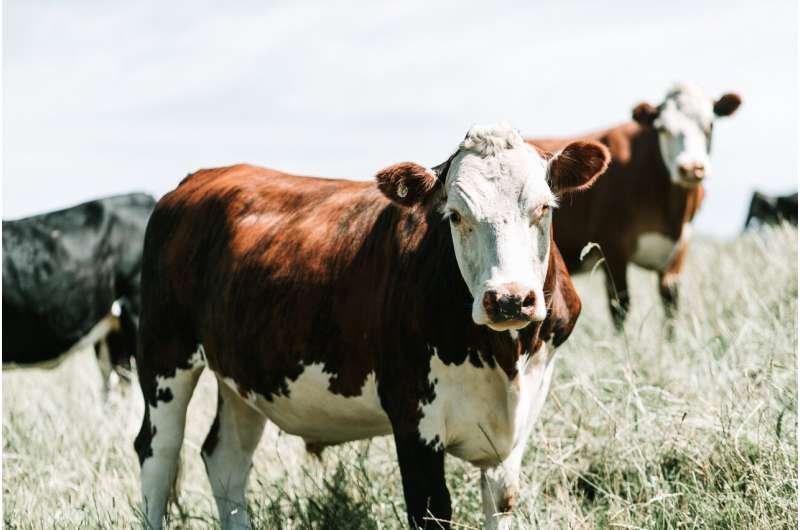This article has been reviewed according to Science X's editorial process and policies. Editors have highlighted the following attributes while ensuring the content's credibility:
fact-checked
trusted source
proofread
Study finds that colostrum is key to saving beef calves from trouble

In a pair of recent studies, researchers examined risk factors that contribute to insufficient antibody transfer to newborn beef calves, as well as the subsequent negative health effects. They found that the mother's parity (in "heifers" or first-time cow moms vs. older cows) and the need for colostrum intervention were the risk factors most likely to result in insufficient antibody protection. Further, they found that calves with low or failed antibody transfer that do survive have increased medical treatment needs, higher mortality rates and lower body weights.
The studies, appearing in Preventive Veterinary Medicine, are published as part 1 and part 2.
The studies illuminate the connection between antibody transfer and calf health, and point to a need for beef calf-specific colostrum intervention strategies and better vaccine management for pregnant cows and heifers.
The first 24 hours of a beef calf's life are crucial, in part because that's when they receive their mother's colostrum—the antibody-rich first milk that transfers protection to the calf against various diseases.
"We really wanted to highlight the connection between antibody transfer and overall beef calf health outcomes—there is a reason colostrum is often referred to as 'liquid gold,'" says Lisa Gamsjäger, assistant professor of population health and pathobiology at North Carolina State University and corresponding author of the research. Gamsjäger did the work while at the University of Calgary in Canada.
Gamsjäger and colleagues took blood samples from 420 beef calves between one and seven days after birth. They measured the total antibody, or immunoglobulin G (IgG) concentration, and then looked at immunoglobulin levels that were specific to common beef calf diarrheal and respiratory diseases such as E. coli, bovine rotavirus and bovine viral diarrhea virus (BVDV), among others.
The researchers also looked at the calves' source of colostrum.
"The mean total IgG concentration across all the calves was 39.9 grams/liter (g/l), which is outstanding," Gamsjäger says. "For context, 24g/l or higher was considered an adequate antibody transfer, 23g/l to 10g/l was inadequate, and below 10g/l was a failed transfer."
Overall, 18% of the calves had an inadequate transfer, and 5% had a failed transfer.
In terms of specific antibody concentrations, the researchers saw that calves born to mature cows had higher pathogen-specific antibodies compared to those born to heifers.
"Mature cows have had more exposure to the diseases for that particular herd, and they may have had more pathogen-specific vaccines," Gamsjäger says. "Heifers often receive their first vaccines during pregnancy and in our study population, many didn't get a booster as recommended by the vaccine manufacturers. Vaccines that are administered at the correct times are thought to increase the amount of antibodies present in the colostrum."
The researchers also saw that the source of calf colostrum was important.
"The biggest risk factor for insufficient antibody transfer is colostrum intervention, which means the calves don't nurse their mothers as they should but need to be given a colostrum replacement product," Gamsjäger says. "This does not mean that colostrum intervention is bad—quite the opposite, in fact—but it tells us that currently we aren't doing it in ways that provide sufficient antibody transfer to those high-risk calves."
"The colostrum replacement used originates from dairy cows," Gamsjäger adds. "Herd histories and exposures are different. Additionally, powdered colostrum products lack maternal immune cells and may have a different bacterial microbiota composition, all of which could have contributed to some of our findings."
In the second study, the team looked at the health outcomes for calves with failed or inadequate antibody transfer. Calves with failed transfer were eight times more likely to need treatment with costly antimicrobial drugs, and 19 times more likely to die, than those with adequate transfer. And for those that survived, their body weight at weaning was 40 pounds less on average than that of calves with adequate transfer.
"This work highlights the risk factors associated with poor passive immunity transfer and the resulting devastating economic and animal welfare implications," Gamsjäger says. "And while the percentages of poor or failed transfer we saw here are lower than in some other recent studies, we can still do better.
"I'm hopeful that our research can lead to improved strategies for managing these calves, such as developing a beef calf-specific colostrum replacement, as well as some evidence-based colostrum management guidelines for beef calves, which should include appropriate vaccine scheduling for cows and heifers."
Claire Windeyer, paper co-author from the University of Calgary, was Gamsjäger's Ph.D. supervisor. Michel Lévy and Edmond Pajor, also from the University of Calgary, as well as Deborah Haines and John Campbell from the University of Saskatoon, Saskatchewan, also contributed to the work.
More information: Lisa Gamsjäger et al, Total and pathogen-specific serum Immunoglobulin G concentrations in neonatal beef calves, Part 1: Risk factors, Preventive Veterinary Medicine (2023). DOI: 10.1016/j.prevetmed.2023.106026
Lisa Gamsjäger et al, Total and pathogen-specific serum Immunoglobulin G concentrations in neonatal beef calves, Part 2: Associations with health and growth, Preventive Veterinary Medicine (2023). DOI: 10.1016/j.prevetmed.2023.105993
Provided by North Carolina State University




















